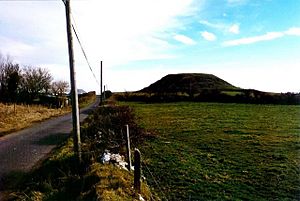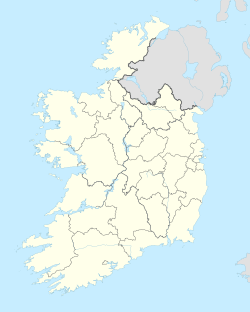Dunnamona facts for kids
|
Dún na Móna
|
|||||||||||
 |
|||||||||||
| Location | Dunnamona, Drumraney, County Westmeath, Ireland |
||||||||||
|---|---|---|---|---|---|---|---|---|---|---|---|
| Region | Tethbae | ||||||||||
| Coordinates | 53°29′58″N 7°47′01″W / 53.499548°N 7.783629°W | ||||||||||
| Type | motte | ||||||||||
| Diameter | 36 m (118 ft) | ||||||||||
| Height | 9 metres (30 ft) | ||||||||||
| History | |||||||||||
| Builder | Dillon family | ||||||||||
| Material | earth | ||||||||||
| Founded | 12th century | ||||||||||
| Periods | Norman Ireland | ||||||||||
| Cultures | Cambro-Norman, Old English | ||||||||||
| Site notes | |||||||||||
| Public access | yes | ||||||||||
| Designation |
|
||||||||||
Dunnamona is an old site in County Westmeath, Ireland. It features a special type of early castle called a motte-and-bailey. Today, it is protected as a National Monument because of its historical importance.
Where is Dunnamona?
The Dunnamona motte is found near a small river that flows into the Owenacharra River. It is about 4.7 kilometers (just under 3 miles) east of a place called Tubberclare.
History of Dunnamona
Motte-and-bailey castles were the first type of castles built by the Normans. The Normans were people who came to Ireland from France and England a long time ago. They arrived in the 12th century.
These early castles were quite simple. They had a large mound of earth, which was the "motte." On top of this mound, there was usually a wooden fence or wall called a palisade. This helped protect the people inside.
The area around Dunnamona was given to the Dillon family. They were descendants of Sir Henry de Leon. The Dillons built the motte at Dunnamona. The name "Dunnamona" means "hillfort of peat," which tells us about the local landscape.
The Dillon family also built another motte nearby in Drumraney. However, these wooden castles were not meant to last forever. Over time, families like the Dillons replaced their mottes with stronger, permanent castles made of stone. This shows how castle building changed over the centuries.


